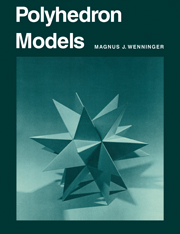Book contents
- Frontmatter
- Dedication
- Contents
- Preface to 1978 reprint
- Preface
- Foreword
- Introduction: uniform polyhedra
- Mathematical classification
- Section I The Convex Uniform Polyhedra: The Platonic and Archimedean Solids
- Section II Some Stellations and Compounds
- Commentary on stellations and compounds of the Platonic solids
- The stellated octahedron (19)
- Stellations of the dodecahedron (20–22)
- Commentary on the stellated icosahedron
- Stellations of the icosahedron (23–42)
- Commentary on the stellation of the Archimedean solids
- Stellations of the cuboctahedron (43–46)
- Commentary on the icosidodecahedron
- Stellations of the icosidodecahedron (47–66)
- Section III Non-convex Uniform Polyhedra
- Epilogue
- References
- List of models
Commentary on the stellated icosahedron
from Section II - Some Stellations and Compounds
Published online by Cambridge University Press: 05 August 2015
- Frontmatter
- Dedication
- Contents
- Preface to 1978 reprint
- Preface
- Foreword
- Introduction: uniform polyhedra
- Mathematical classification
- Section I The Convex Uniform Polyhedra: The Platonic and Archimedean Solids
- Section II Some Stellations and Compounds
- Commentary on stellations and compounds of the Platonic solids
- The stellated octahedron (19)
- Stellations of the dodecahedron (20–22)
- Commentary on the stellated icosahedron
- Stellations of the icosahedron (23–42)
- Commentary on the stellation of the Archimedean solids
- Stellations of the cuboctahedron (43–46)
- Commentary on the icosidodecahedron
- Stellations of the icosidodecahedron (47–66)
- Section III Non-convex Uniform Polyhedra
- Epilogue
- References
- List of models
Summary
The meaning of stellation should now be making itself apparent to you. Some stellations are compounds. So far you have seen only one case of this, the stellated octahedron. But more are now found in the case of the icosahedron. In the case of the dodecahedron all three of its stellations turn out to be genuinely new polyhedra, in fact they all classify as regular.
The icosahedron has twenty faces and if all twenty facial planes are extended indefinitely you may well imagine, or more likely you may well fail to imagine, the multitude of cells enclosed within these intersecting planes. It is a fact that stellations of the icosahedron may all be derived from the cells enclosed within these planes. Besides the icosahedron itself you will find
20 + 30 + 60 + 20 + 60+ 120 + 12 + 30 + 60 + 60 cells of ten different shapes and sizes. The great icosahedron is composed of all but the last sixty pieces. In making models of these stellated forms, and this holds for the octahedral and dodecahedral as well, you can make these cells first, once you have worked out their nets, and then you can cement the cells to a polyhedron base or to each other. But in practice this does not give a satisfactory result and would be extremely tedious. However, acquaintance with the cell forms is very helpful in working out nets that are practical. In the following descriptions you will find these nets given for you. Once you have done some of these, or certainly by the time you have done all of them, you will be able to find many more on your own. The nets given here are not necessarily the only possible ones or the best ones. They are merely those actually used in the construction of the models pictured in the photographs.
- Type
- Chapter
- Information
- Polyhedron Models , pp. 41 - 42Publisher: Cambridge University PressPrint publication year: 1971



